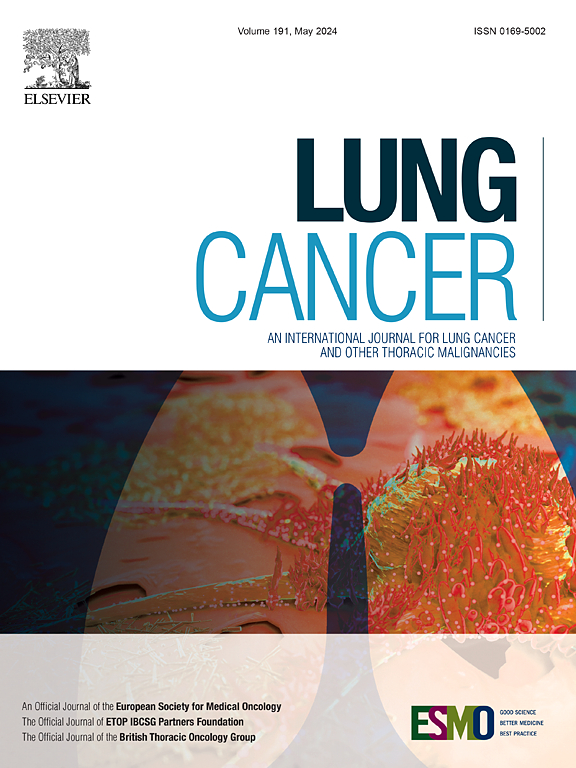Associations between progastrin-releasing peptide (ProGRP) and neuron-specific enolase (NSE) and survival in patients with limited-stage small cell lung cancer (LS SCLC) receiving chemoradiotherapy (CRT)
IF 4.4
2区 医学
Q1 ONCOLOGY
引用次数: 0
Abstract
Background
There are no established biomarkers for predicting outcomes of chemoradiotherapy (CRT) in limited-stage small cell lung cancer (SCLC). Progastrin-releasing peptide (ProGRP) is a more sensitive and specific biomarker of SCLC than neuron-specific enolase (NSE). We investigated whether ProGRP was associated with treatment outcomes in a randomized phase II trial of LS SCLC (n = 170).
Methods
Patients received platinum–etoposide chemotherapy and were randomized to receive twice-daily (BID) thoracic radiotherapy (TRT) of either 45 Gy or 60 Gy. Patients commencing TRT with baseline measurements of ProGRP and NSE were eligible for this study.
Results
We analyzed 89 patients. Median age was 65 years, 56.2 % were female, 89.9 % had performance status 0–1, and 85.4 % had stage III disease. At baseline, 79.8 % had elevated ProGRP and 58.4 % elevated NSE. After CRT, 23.6 % had elevated ProGRP and 5.6 % elevated NSE. Patients with elevated ProGRP at baseline had shorter PFS (median 12.2 months vs. not reached [NR], p = 0.006) and OS (median 29.3 months vs. NR, p = 0.001) than patient. Similarly, elevated ProGRP after CRT was associated with shorter PFS (median 11.1 months vs. NR, p = 0.006) and OS (median 30.6 months vs. NR, p = 0.002). Patients with elevated baseline ProGRP but normalized ProGRP after CRT had longer PFS (median 49.3 months vs. 7.8 months, p = 0.003) and OS (median NR vs. 30.5, p < 0.001) than patients with persistently elevated ProGRP. All associations remained significant in multivariable analyses. NSE was not associated with PFS or OS.
Conclusion
ProGRP levels at baseline and after CRT were associated with PFS and OS in patients with LS SCLC.
接受放化疗(CRT)的有限期小细胞肺癌(LS SCLC)患者的原胃泌素释放肽(ProGRP)和神经元特异性烯醇化酶(NSE)与生存率的关系
目前还没有确定的生物标志物来预测有限期小细胞肺癌(SCLC)放化疗(CRT)的预后。Progastrin-releasing peptide (ProGRP)是一种比神经元特异性烯醇化酶(NSE)更敏感和特异性的SCLC生物标志物。在一项随机II期试验中,我们研究了ProGRP是否与LS SCLC的治疗结果相关(n = 170)。方法患者接受铂-依托泊苷化疗,随机接受45 Gy或60 Gy每日两次(BID)胸部放疗(TRT)。以ProGRP和NSE基线测量开始TRT的患者符合本研究的条件。结果我们分析了89例患者。中位年龄为65岁,56.2%为女性,89.9%表现为0-1,85.4%为III期疾病。基线时,79.8%的患者ProGRP升高,58.4%的患者NSE升高。CRT后,23.6%的患者ProGRP升高,5.6%的患者NSE升高。基线时ProGRP升高的患者的PFS(中位12.2个月vs未达到[NR], p = 0.006)和OS(中位29.3个月vs未达到NR, p = 0.001)均短于患者。同样,CRT后ProGRP升高与较短的PFS(中位11.1个月vs NR, p = 0.006)和OS(中位30.6个月vs NR, p = 0.002)相关。基线ProGRP升高但CRT后ProGRP正常化的患者有更长的PFS(中位49.3个月vs 7.8个月,p = 0.003)和OS(中位NR vs 30.5, p <;0.001)高于ProGRP持续升高的患者。在多变量分析中,所有关联仍然显著。NSE与PFS和OS无相关性。结论基线和CRT后progrp水平与LS SCLC患者的PFS和OS相关。
本文章由计算机程序翻译,如有差异,请以英文原文为准。
求助全文
约1分钟内获得全文
求助全文
来源期刊

Lung Cancer
医学-呼吸系统
CiteScore
9.40
自引率
3.80%
发文量
407
审稿时长
25 days
期刊介绍:
Lung Cancer is an international publication covering the clinical, translational and basic science of malignancies of the lung and chest region.Original research articles, early reports, review articles, editorials and correspondence covering the prevention, epidemiology and etiology, basic biology, pathology, clinical assessment, surgery, chemotherapy, radiotherapy, combined treatment modalities, other treatment modalities and outcomes of lung cancer are welcome.
 求助内容:
求助内容: 应助结果提醒方式:
应助结果提醒方式:


